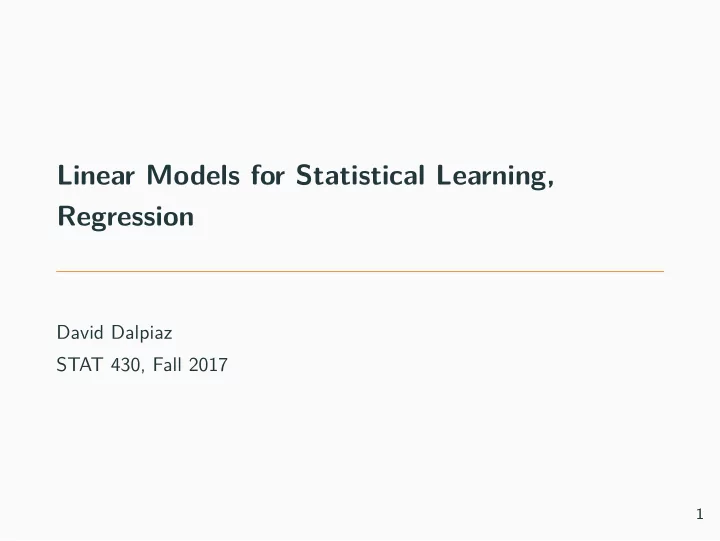

Linear Models for Statistical Learning, Regression David Dalpiaz STAT 430, Fall 2017 1
Announcements • Homework 01 due today. • Homework 02 released later today. (Hopefully.) 2
Statistical Learning • Supervised Learning • Regression • Classification • Unsupervised Learning 3
Regression Setup Y = f ( x 1 , x 2 , x 3 , . . . x p ) + ǫ numeric response = signal + noise • Want to learn the signal • Want to be very careful not to “learn noise” 4
Using a Linear Model Setup: Y = f ( x 1 , x 2 , x 3 , . . . x p ) + ǫ Assume: f ( x 1 , x 2 , x 3 , . . . x p ) = β 0 + β 1 x 1 + β 2 x 2 + . . . + β p x p 5
The Linear Model ǫ ∼ N (0 , σ 2 ) Y = β 0 + β 1 x 1 + β 2 x 2 + . . . + β p x p + ǫ, Y | X ∼ N ( β 0 + β 1 x 1 + β 2 x 2 + . . . + β p x p , σ 2 ) There are a total of p + 2 parameters in this model • The p + 1 β parameters, or coefficients, control the signal • The σ 2 controls the noise 6
Fitting a Linear Model This is a parametric model, meaning to fit the model, we need to estimate the parameters. For the sake of making predictions, we only need to estimate the β parameters since ˆ y ( x 1 , x 2 , x 3 , . . . x p ) = ˆ β 0 +ˆ β 1 x 1 +ˆ β 2 x 2 + . . . +ˆ f ( x 1 , x 2 , x 3 , . . . x p ) = ˆ β p x p Using either least squares or maximum likelihood , this becomes the same optimization problem n � ( y i − ( β 0 + β 1 x i 1 + β 2 x i 2 + · · · + β p x ip )) 2 argmin β 0 ,β 1 ,...β p i =1 7
Estimating σ 2 While it is not needed to make predictions, to fully estimate the model, we would also need to estimate σ 2 . n 1 s 2 � y i ) 2 e = ( y i − ˆ Least Squares n − ( p + 1) i =1 n σ 2 = 1 � y i ) 2 ˆ ( y i − ˆ MLE n i =1 Both are estimates of σ 2 . What is the difference? 8
Model “Size” Consider two models: Y = β 0 + β 1 x 1 + β 2 x 2 + ǫ Y = β 0 + β 1 x 1 + β 2 x 2 + β 3 x 3 + β 4 x 4 + ǫ Which is bigger? 9
Model Complexity In general, we are interested in the complexity or flexibility of a model. For nested linear models, the more parameters, the bigger, thus, more complex. Models that are more complex will be more wiggly . 10
Pictures of Complexity Go to ISL Slides 11
Test-Train Split We’ve already discussed the Test-Train Split and RMSE � � 1 � 2 � RMSE Train = RMSE(ˆ � y i − ˆ � f , Train Data) = f ( x i ) � n Tr i ∈ Train � � 1 � 2 � � RMSE Test = RMSE(ˆ � y i − ˆ f , Test Data) = f ( x i ) � n Te i ∈ Test 12
Overfitting • Overfitting occurs when a model is too complex (too flexible) for the data • Underfitting occurs when a model is not complex enough (too inflexible) for the data 13
Train RMSE Prediction Error vs Model Complexity 3.0 2.5 2.0 Error (RMSE) 1.5 1.0 0.5 0.0 0 20 40 60 80 100 Complexity (Parameters) 14
(Expected) Test RMSE Prediction Error vs Model Complexity 3.0 2.5 2.0 Error (RMSE) 1.5 1.0 0.5 (Expected) Test 0.0 Train 0 20 40 60 80 100 Complexity (Parameters) 15
The “Best” Model • Pick the model with the lowest Test RMSE • Compared to this. . . • More complex models with higher Test RMSE are Overfitting • Less complex models with higher Test RMSE are Underfitting • This is only a “guess” of the “best” model based on available information • In practice, Test RMSE might not be such a nice curve • This is due to the randomness of the split • You could get lucky, or unlucky 16
Explanation vs Prediction • Sometimes we check model assumptions directly • When predicting, we make assumptions and check them indirectly • If we assume a correct (or close to correct) form of the model, the Test RMSE will be low 17
If Time. . . • rmarkdown Tables • Using code from the Internet • Back to Test-Train Split Lab • What would be a good Test RMSE? • Overfitting: n vs p • Randomness of Split • Pseudo RNG 18
Recommend
More recommend